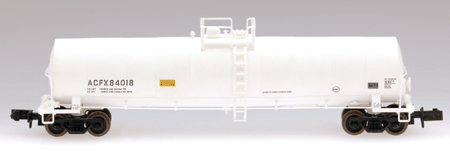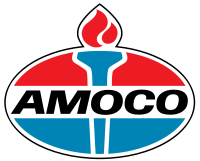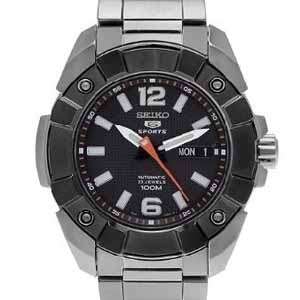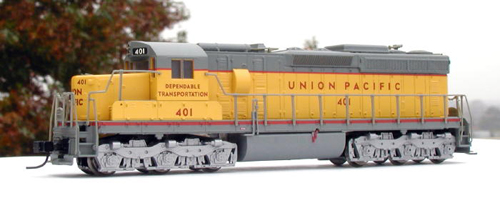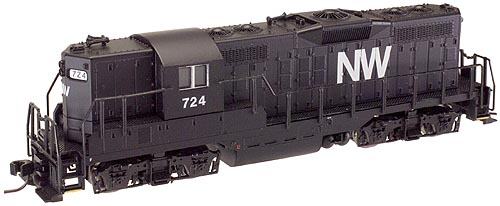Model Information: This model was introduced by Atlas in March of 2000. It features:
Separately molded brake line plumbing;
Ultra-thin handrails;
Tank fittings and safety placards;
100-ton roller-bearing trucks;
Brake wheel chain detail;
Accurate painting and lettering;
AccuMate magnetic knuckle couplers.
Prototype History: ACF® Industries built a general-purpose, single-compartment, 23,500 gallon, insulated, coiled, non-pressurized tank car from 1969 on. The cars are still in service today. A wide variety of products can be transported in this size and type of tank car. This includes asphalt, ethanol, fuel oil, metal sodium, molten phenol, paraffin wax, tallow, urethane polyol, and vegetable oil. They are mostly owned by the companies that produce the products carried, rather than the railroads themselves.
Road Name History: Amoco Corporation, originally Standard Oil Company (Indiana), was a global chemical and oil company that was founded in 1889 around a refinery located in Whiting, Indiana, United States.
It later absorbed the American Oil Company, founded in Baltimore in 1910 and incorporated in 1922 by Louis Blaustein and his son Jacob. Amoco merged with British Petroleum in December 1998, forming BP Amoco. Shortly after the merger, Amoco stations began a rebranding that saw the stations change their names to the BP marque while continuing to sell Amoco-branded fuel. Eventually all traces of the Amoco brand name were eliminated and the stations adopted the BP branding permanently, although Amoco's grade naming system is still in use.
The firm's innovations included two essential parts of the modern industry, the gasoline tanker truck and the drive-through filling station.[1] Its headquarters were located in the Amoco Building (now the Aon Center) in Chicago, Illinois.
From Wikipedia
It later absorbed the American Oil Company, founded in Baltimore in 1910 and incorporated in 1922 by Louis Blaustein and his son Jacob. Amoco merged with British Petroleum in December 1998, forming BP Amoco. Shortly after the merger, Amoco stations began a rebranding that saw the stations change their names to the BP marque while continuing to sell Amoco-branded fuel. Eventually all traces of the Amoco brand name were eliminated and the stations adopted the BP branding permanently, although Amoco's grade naming system is still in use.
The firm's innovations included two essential parts of the modern industry, the gasoline tanker truck and the drive-through filling station.[1] Its headquarters were located in the Amoco Building (now the Aon Center) in Chicago, Illinois.
From Wikipedia
Brand/Importer Information: In 1924 Stephan Schaffan, Sr. founded the Atlas Tool Company in Newark, New Jersey. In 1933 his son, Stephan Schaffan, Jr., came to work for his father at the age of sixteen. Steve Jr. built model airplanes as a hobby and frequented a local hobby shop. Being an enterprising young man, he would often ask the owner if there was anything he could do to earn some extra spending money. Tired of listening to his requests, the hobby-store owner threw some model railroad track parts his way and said, "Here, see if you can improve on this".
In those days, railroad modelers had to assemble and build everything from scratch. Steve Jr. created a "switch kit" which sold so well, that the entire family worked on them in the basement at night, while doing business as usual in the machine shop during the day.
Subsequently, Steve Jr. engineered the stapling of rail to fiber track, along with inventing the first practical rail joiner and pre-assembled turnouts and flexible track. All of these products, and more, helped to popularize model railroading and assisted in the creation of a mass-market hobby. The budding entrepreneur quickly outgrew the limitations of a basement and small garage operation. Realizing they could actually make a living selling track and related products, Steve and his father had the first factory built in Hillside, New Jersey at 413 Florence Avenue in 1947. On September 30, 1949, the Atlas Tool Company was officially incorporated as a New Jersey company.
In 1985, Steve was honored posthumously for his inventions by the Model Railroad Industry Association and was inducted into the Model Railroad Industry Hall of Fame in Baltimore, Maryland. In addition, Steve was nominated and entered into the National Model Railroad Association Pioneers of Model Railroading in 1995.
In the early 1990s, the Atlas Tool Company changed its name to Atlas Model Railroad Company, Inc.
In those days, railroad modelers had to assemble and build everything from scratch. Steve Jr. created a "switch kit" which sold so well, that the entire family worked on them in the basement at night, while doing business as usual in the machine shop during the day.
Subsequently, Steve Jr. engineered the stapling of rail to fiber track, along with inventing the first practical rail joiner and pre-assembled turnouts and flexible track. All of these products, and more, helped to popularize model railroading and assisted in the creation of a mass-market hobby. The budding entrepreneur quickly outgrew the limitations of a basement and small garage operation. Realizing they could actually make a living selling track and related products, Steve and his father had the first factory built in Hillside, New Jersey at 413 Florence Avenue in 1947. On September 30, 1949, the Atlas Tool Company was officially incorporated as a New Jersey company.
In 1985, Steve was honored posthumously for his inventions by the Model Railroad Industry Association and was inducted into the Model Railroad Industry Hall of Fame in Baltimore, Maryland. In addition, Steve was nominated and entered into the National Model Railroad Association Pioneers of Model Railroading in 1995.
In the early 1990s, the Atlas Tool Company changed its name to Atlas Model Railroad Company, Inc.
Item created by: Steve German on 2016-04-23 14:11:05. Last edited by Alain LM on 2020-06-20 15:41:24
If you see errors or missing data in this entry, please feel free to log in and edit it. Anyone with a Gmail account can log in instantly.
If you see errors or missing data in this entry, please feel free to log in and edit it. Anyone with a Gmail account can log in instantly.


